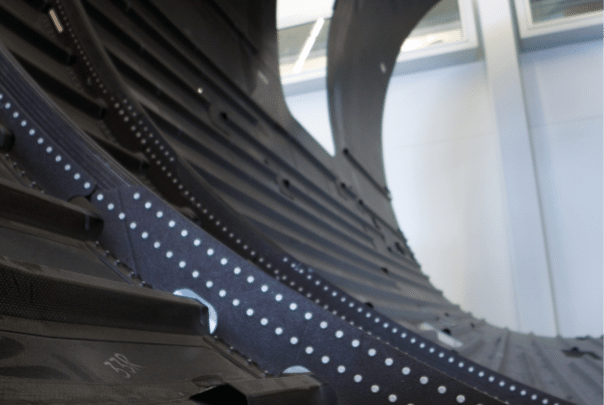Multidisciplinary structural optimization
Multidisziplinäres Optimierungssystem für den Detailentwurf von Leichtbaustrukturen aus Verbundwerkstoffen
Keine anderen Themen bestimmten von Beginn an die Entwicklung der Luftfahrt, wie die Entwicklungen leichter Strukturelemente und effizienter Antriebssysteme. Verbesserungen in einem dieser beiden Bereiche ergeben unmittelbare Vorteile für die Leistungsfähigkeit eines Luftfahrzeuges, wie zum Beispiel hinsichtlich Nutzlast, Reichweite oder Treibstoffverbrauch.
Gemeinsam mit IngenieurInnen von Airbus Defence and Space arbeitet die RISC Software seit mehr als acht Jahren an der Weiterentwicklung eines Softwaresystems zur Berechnung und Konstruktion gewichtsoptimaler Entwürfe von Flugzeugstrukturen. Von besonderer Bedeutung ist dabei, dass bereits in einer möglichst frühen Konstruktionsphase die optimale Geometrie und die bestmögliche Verwendung spezialisierter Materialien für die Gesamtstruktur betrachtet werden können. Zu diesem Zeitpunkt sind die Entwurfsfreiheiten am größten und damit steht das größte Potenzial für Gewichtseinsparungen zur Verfügung.
Um dies zu ermöglichen, wurde bei Airbus Defence and Space das multidisziplinäre Strukturoptimierungssystem Lagrange entwickelt, mit dessen Hilfe Leichtbaustrukturen bezüglich unterschiedlicher Entwurfsparameter optimiert werden können. Beispiele für Entwurfsparameter sind unter anderem Querschnitte einzelner Bauteile oder ganzer Bauteilgruppen, aber ebenso Lagendicken und Bahnverläufe von Faserverbundmaterialien.
Neben dem Konstruktionsziel, dass für ein Strukturelement ein minimales Gewicht erreicht wird, müssen gleichzeitig eine Vielzahl unterschiedlicher mechanischer und physikalischer Anforderungen berücksichtigt werden. Das Optimierungssystem Lagrange stellt dabei ein breites Spektrum relevanter multidisziplinärer Analyse- und Kriterienmodelle bereit. So können neben einer Reihe mechanischer Festigkeitskriterien und Stabilitätskriterien auch unterschiedliche Restriktionen bezüglich Eigenschwingungen, Flattergeschwindigkeiten oder anderer aeroelastischer Wechselwirkungen formuliert werden.
Eine wesentliche Fähigkeit zur Automatisierung des Gesamtentwurfsprozesses ist eine gekoppelte Aerodynamik-Struktur-Analyse (Aeroelastik). Dadurch können beim Entwurf zusätzlich zur Dimensionierung der Strukturelemente auch aerodynamische Lasten als Teil der Optimierung aktiv beeinflusst werden. Zusätzlich ermöglicht Lagrange auch die Berücksichtigung spezieller Fertigungsrestriktionen für Faserverbundwerkstoffe, sodass sichergestellt ist, dass die berechneten Entwürfe auch mit den zur Verfügung stehenden Methoden gefertigt werden können.
Damit können bereits am Beginn der Entwurfsphase sehr realitätsnahe Konstruktionsentwürfe, deren Modelle mehrere tausend Entwurfsvariablen und mehrere hunderttausend Randbedingungen beinhalten, optimiert werden.
Seit 2009 ist die RISC Software Hauptentwicklungspartnerin für die Neuentwicklung zentraler Systemteile von Lagrange. Von besonderer Bedeutung ist dabei die Implementierung modernster, effizienter Berechnungsmethoden und die bestmögliche Nutzung moderner Hardwareplattformen, insbesondere im Hinblick auf parallele und verteilte Rechnerarchitekturen.

Projektpartner

Details zum Projekt
- Projekt-Kurztitel: Multidisziplinäre Strukturoptimierung
- Projekt-Langtitel: Multidisziplinäres Optimierungssystem für den Detailentwurf von Leichtbaustrukturen aus Verbundwerkstoffen
- Projektpartner*innen:
- Airbus Defense and Space
- Laufzeit: laufend
Ansprechperson

Dr. DI Christoph Hofer, BSc
Software Engineer